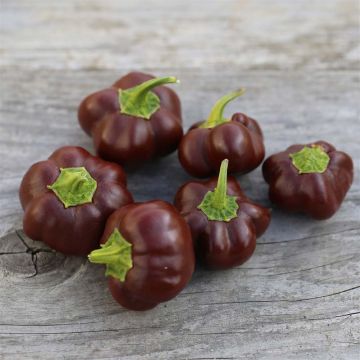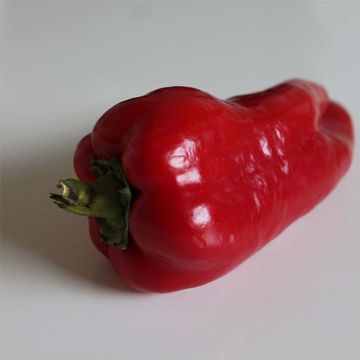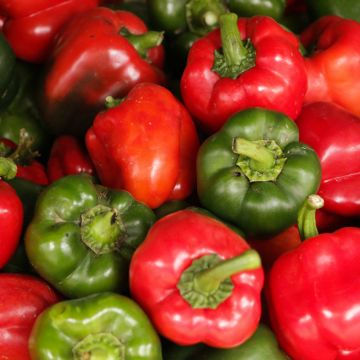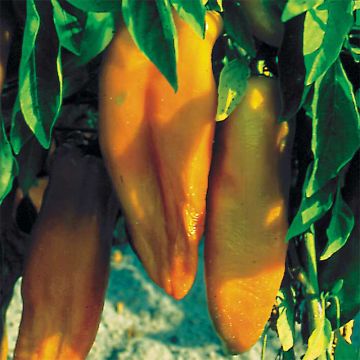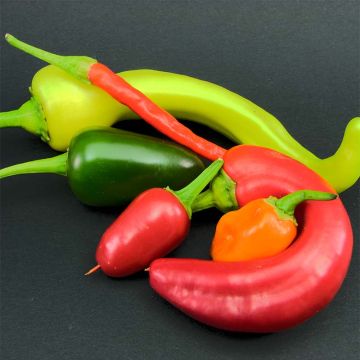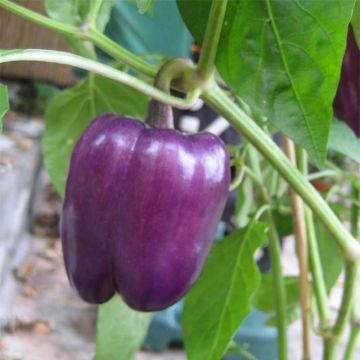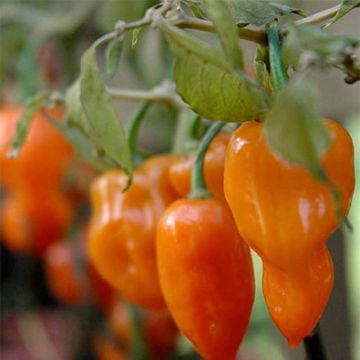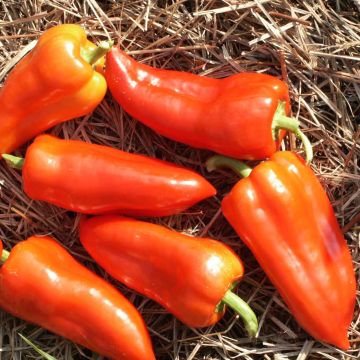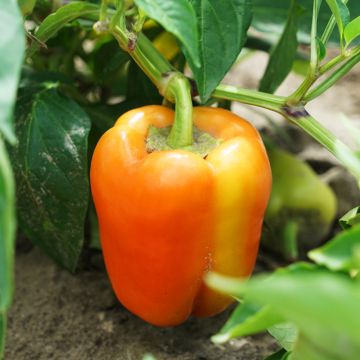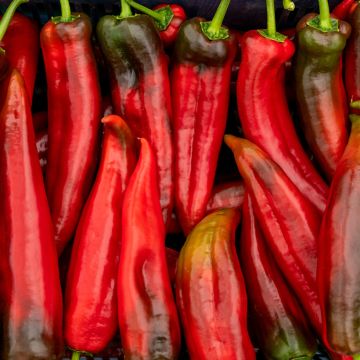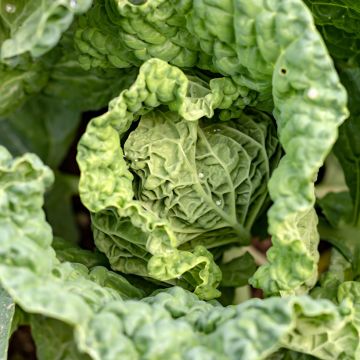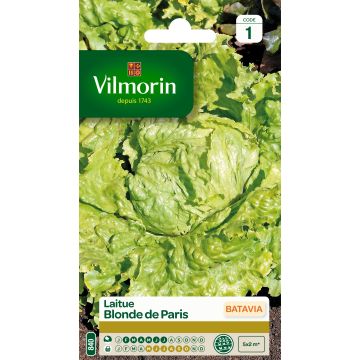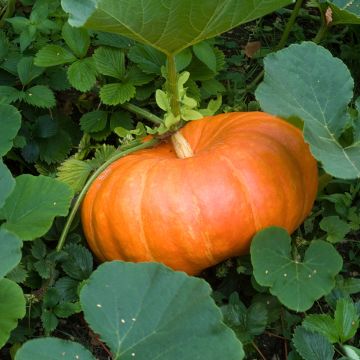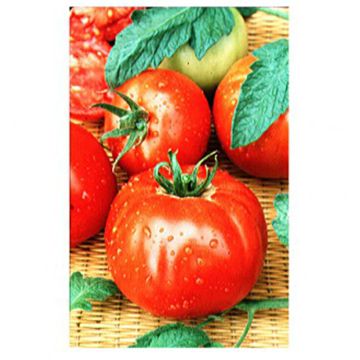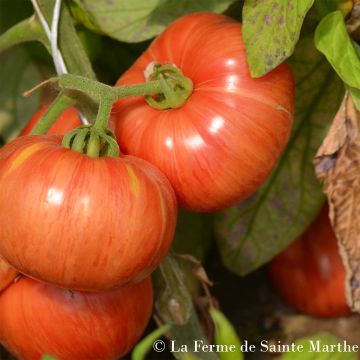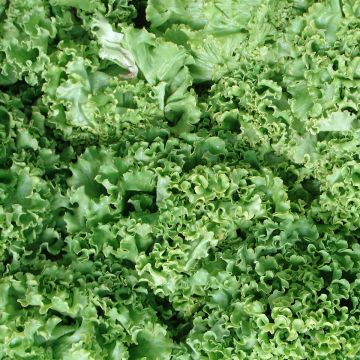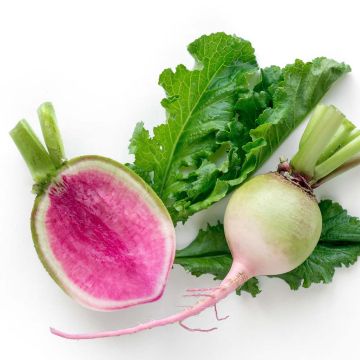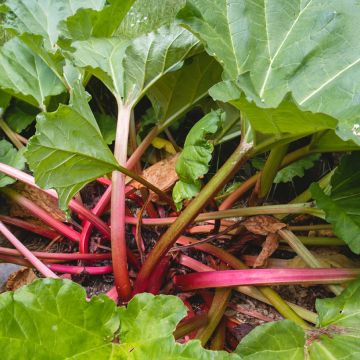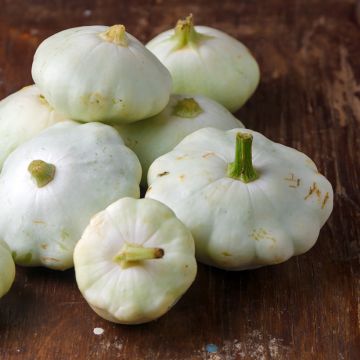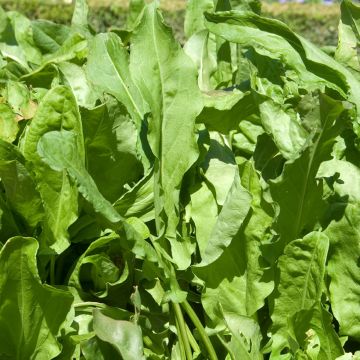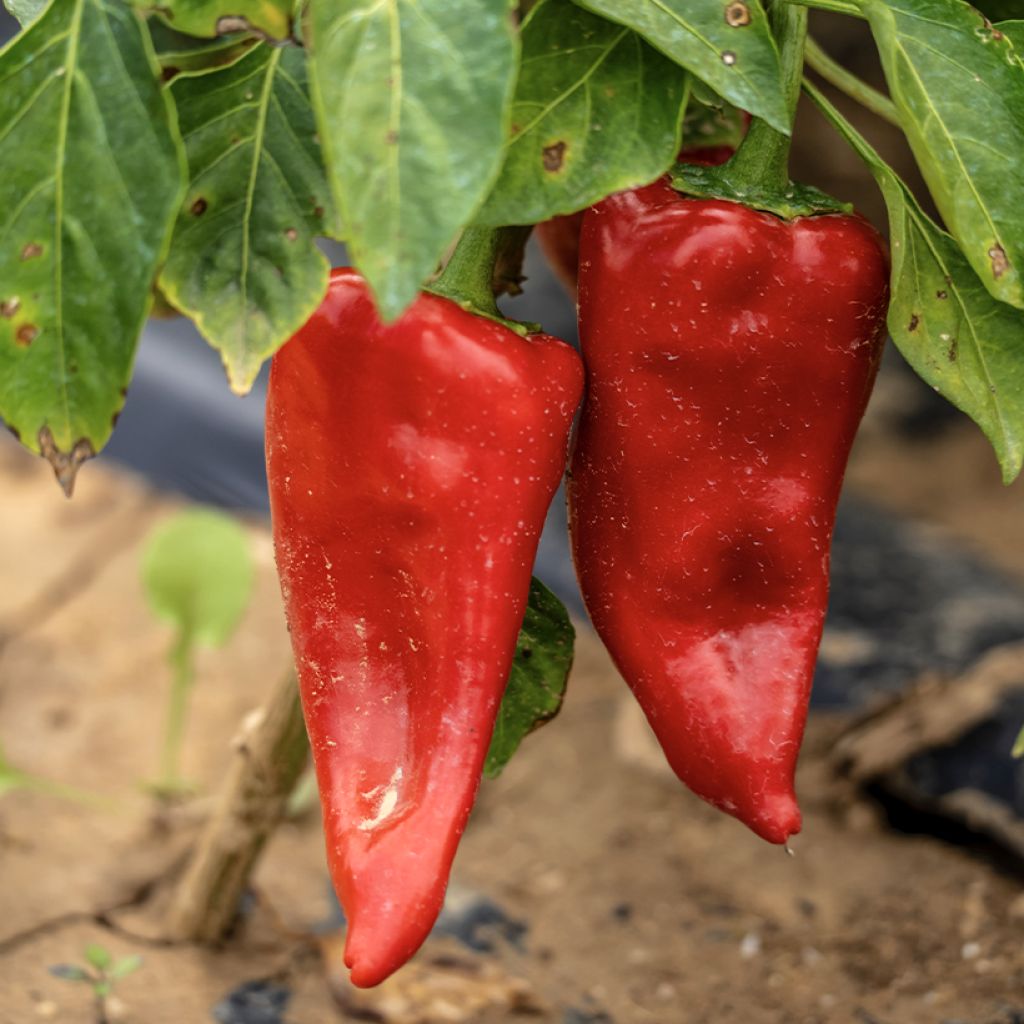

Piquillo pepper organic seeds
Piquillo pepper organic seeds
Capsicum annuum Piquillo
Piquillo pepper, Piquillo
This item cannot be shipped to the selected country
Delivery charge from €5.90
More information
Schedule delivery date,
and select date in basket
This plant carries a 6 months recovery warranty
More information
We guarantee the quality of our plants for a full growing cycle, and will replace at our expense any plant that fails to recover under normal climatic and planting conditions.
From €5.90 for pickup delivery and €6.90 for home delivery
Express home delivery from €8.90.
Description
The 'Piquillo' pepper, originating from the Navarre region in Spain, is a variety known for its mild flavour and specific culinary use. Small and rather triangular, the fruit measures between 7 and 10 cm long and takes on a bright red hue when ripe. Its fine and bitter-free flesh is sought after. Appreciated for its melting texture and slight smoky note when grilled, the 'Piquillo' has become an emblematic product of Spanish gastronomy. It benefits from a Protected Geographical Indication (PGI) when grown in certain areas, notably in Lodosa, thus guaranteeing its origin and quality.
In the kitchen: the Piquillo is mainly used grilled to remove its skin, which enhances its natural sweetness. It is then preserved in oil or vinegar, or stuffed with various ingredients such as cheese, meat, or vegetables. This pepper is also highly prized to accompany meat and fish dishes, or to be served alone as tapas.
Cultivation-wise, the 'Piquillo' pepper prefers hot and sunny climates. Sow under cover from February to May, then they are transplanted into open ground or pots after the last frosts. A mature plant reaches approximately 60 cm in height. Full sun exposure and well-drained soil are essential to ensure a bountiful harvest from July through autumn. Easy to grow under appropriate conditions, it is suitable for vegetable gardens and container gardening on balconies.
Peppers, close relatives of chillies, stand out for their absence or very low content of capsaicin, the substance responsible for spiciness. Belonging to the Solanaceae family, this plant is perennial in tropical climates but is grown as an annual in our latitudes, unless placed in a pot and overwintered. It produces small white or mauve flowers. Provide it with sun, warmth, and rich soil amended with about 3 kg of compost per square metre.
The pepper is a versatile vegetable fruit, consumed raw in salads, grilled, stuffed, or incorporated into preparations like ratatouille. Harvesting is done based on the variety's colour at ripeness, by gently cutting the stem to extend its shelf life. Peppers can be kept for several days in the refrigerator, but there are other methods to prolong their shelf life: drying (in the sun, in the open air, or in the oven), marinating in oil or vinegar, pureeing, or freezing, after thorough cleaning.
To protect your plants, plant radishes nearby: they help repel red spiders.
Report an error about the product description
Harvest
Plant habit
Foliage
Botanical data
Capsicum
annuum
Piquillo
Solanaceae
Piquillo pepper, Piquillo
South America
Annual
Other Pepper seeds
Planting and care
'Piquillo' peppers are quite easy to grow. Sun and warmth play a determining role in the success of this crop. They will thrive in any soil, although they prefer rich, loose, and well-draining soil. You can mix in a bit of sand if the substrate is too compact.
Sowing under glass: from mid-February to May, sow indoors or in heated greenhouses in trays at around 20°C. Bury the seeds under 5 to 7 mm of seed compost as they need darkness to germinate. Do not use fertiliser at this stage, as you could risk burning the future roots. Pepper plants grow quickly: seeds germinate between 3 days and a week after sowing. This is an average. Do not discard a tray if germination has not occurred within this time frame thinking they are irrecoverable. Some varieties are slow and take their time. When the plants have reached 5 to 6 true leaves, repot them into pots that will provide a bit more space for their roots and start acclimatising them outdoors on sunny days.
Transplanting in open ground: once the risk of frost is over, usually around mid-May, transplant your plants into open ground. Choose the sunniest and warmest spots in the garden. At the base of a wall facing due South is an ideal position. Loosen the soil and then dig a hole at least 3 to 4 times the volume of the root system of your plant. Add some well-decomposed compost at the bottom. Plant your seedling which can be buried up to the first leaves and then backfill. Firm the soil, create a basin around the plant, then water generously. Be careful not to water the leaves to protect your plants from fungal diseases. If you plan to plant several plants, space them 60 cm apart in all directions.
Maintenance: laying mulch at the base of your plants helps maintain some moisture and avoids the need for weeding. Pepper plants do not require much watering: their root system has a taproot that searches deeply for available resources. Water generously only in case of prolonged drought. If you have chosen to grow in a pot, you can keep your Pepper plants for several years by storing them in a warm and light place during the off-season. In a pot, the plant cannot develop as efficient a taproot as in open ground. It is then necessary to water it regularly, but moderately.
Seedlings
Care
Intended location
This item has not been reviewed yet - be the first to leave a review about it.
Vegetable seeds
Haven't found what you were looking for?
Hardiness is the lowest winter temperature a plant can endure without suffering serious damage or even dying. However, hardiness is affected by location (a sheltered area, such as a patio), protection (winter cover) and soil type (hardiness is improved by well-drained soil).

Photo Sharing Terms & Conditions
In order to encourage gardeners to interact and share their experiences, Promesse de fleurs offers various media enabling content to be uploaded onto its Site - in particular via the ‘Photo sharing’ module.
The User agrees to refrain from:
- Posting any content that is illegal, prejudicial, insulting, racist, inciteful to hatred, revisionist, contrary to public decency, that infringes on privacy or on the privacy rights of third parties, in particular the publicity rights of persons and goods, intellectual property rights, or the right to privacy.
- Submitting content on behalf of a third party;
- Impersonate the identity of a third party and/or publish any personal information about a third party;
In general, the User undertakes to refrain from any unethical behaviour.
All Content (in particular text, comments, files, images, photos, videos, creative works, etc.), which may be subject to property or intellectual property rights, image or other private rights, shall remain the property of the User, subject to the limited rights granted by the terms of the licence granted by Promesse de fleurs as stated below. Users are at liberty to publish or not to publish such Content on the Site, notably via the ‘Photo Sharing’ facility, and accept that this Content shall be made public and freely accessible, notably on the Internet.
Users further acknowledge, undertake to have ,and guarantee that they hold all necessary rights and permissions to publish such material on the Site, in particular with regard to the legislation in force pertaining to any privacy, property, intellectual property, image, or contractual rights, or rights of any other nature. By publishing such Content on the Site, Users acknowledge accepting full liability as publishers of the Content within the meaning of the law, and grant Promesse de fleurs, free of charge, an inclusive, worldwide licence for the said Content for the entire duration of its publication, including all reproduction, representation, up/downloading, displaying, performing, transmission, and storage rights.
Users also grant permission for their name to be linked to the Content and accept that this link may not always be made available.
By engaging in posting material, Users consent to their Content becoming automatically accessible on the Internet, in particular on other sites and/or blogs and/or web pages of the Promesse de fleurs site, including in particular social pages and the Promesse de fleurs catalogue.
Users may secure the removal of entrusted content free of charge by issuing a simple request via our contact form.
The flowering period indicated on our website applies to countries and regions located in USDA zone 8 (France, the United Kingdom, Ireland, the Netherlands, etc.)
It will vary according to where you live:
- In zones 9 to 10 (Italy, Spain, Greece, etc.), flowering will occur about 2 to 4 weeks earlier.
- In zones 6 to 7 (Germany, Poland, Slovenia, and lower mountainous regions), flowering will be delayed by 2 to 3 weeks.
- In zone 5 (Central Europe, Scandinavia), blooming will be delayed by 3 to 5 weeks.
In temperate climates, pruning of spring-flowering shrubs (forsythia, spireas, etc.) should be done just after flowering.
Pruning of summer-flowering shrubs (Indian Lilac, Perovskia, etc.) can be done in winter or spring.
In cold regions as well as with frost-sensitive plants, avoid pruning too early when severe frosts may still occur.
The planting period indicated on our website applies to countries and regions located in USDA zone 8 (France, United Kingdom, Ireland, Netherlands).
It will vary according to where you live:
- In Mediterranean zones (Marseille, Madrid, Milan, etc.), autumn and winter are the best planting periods.
- In continental zones (Strasbourg, Munich, Vienna, etc.), delay planting by 2 to 3 weeks in spring and bring it forward by 2 to 4 weeks in autumn.
- In mountainous regions (the Alps, Pyrenees, Carpathians, etc.), it is best to plant in late spring (May-June) or late summer (August-September).
The harvesting period indicated on our website applies to countries and regions in USDA zone 8 (France, England, Ireland, the Netherlands).
In colder areas (Scandinavia, Poland, Austria...) fruit and vegetable harvests are likely to be delayed by 3-4 weeks.
In warmer areas (Italy, Spain, Greece, etc.), harvesting will probably take place earlier, depending on weather conditions.
The sowing periods indicated on our website apply to countries and regions within USDA Zone 8 (France, UK, Ireland, Netherlands).
In colder areas (Scandinavia, Poland, Austria...), delay any outdoor sowing by 3-4 weeks, or sow under glass.
In warmer climes (Italy, Spain, Greece, etc.), bring outdoor sowing forward by a few weeks.

































